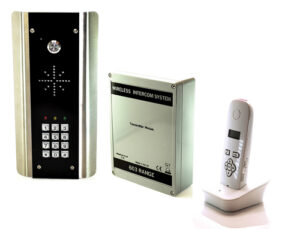 The intercom unit is intended for providing control of access through gates or doors by way of a two-way wireless audio link and relay control.
The intercom unit is intended for providing control of access through gates or doors by way of a two-way wireless audio link and relay control.
Features
Promoted as a wireless intercom for electric gates and doors, utilising DECT technology the unit claims to provide a range of up to 350 metres open field range, or 200 meters through one external wall. This 603ABK model has gate/door release relays built in and includes a code lock keypad with multiple user capability.
The enclosure is defined as an “architectural” speech panel design, other options are hooded, flush and industrial. Blue LED illuminated call button, keypad and backlighting accentuate the user controls.
All panels are constructed from stainless steel, trimmed with gloss black toughened acrylic and include a 2-year manufacturer’s warranty.
Observations
The various components are well presented within the packaging and the heavier items were well secured in place, however some of the smaller items such as the security driver were heard to “rattle around” the box a little but had not strayed from their sections.
The manual states very clearly that it is important to test the range of the unit in the location it is to be used as there can be numerous factors that can reduce the effective transmission range of the 1.88GHz DECT signal.
Getting started
After unpacking all of the items and reading through the manual, the handset was placed on charge in its charging cradle and supply (8 hours’ charge recommended) while the outdoor devices were connected.
The manual stresses the importance of using a suitable grade of Cat 5 screened 4 pair cable between the external intercom unit and the transmitter unit and that this should be limited to 4 metres maximum. A length of approximately 3 metres is supplied with the kit.
It is important to use the correct cable size for the 12-volt input to the transmitter unit as insufficient voltage due to poor cable size is claimed to be the major cause of queries to the AES technical help line. A minimum of 1mm/sq is recommended for up to 4 metres from the supply with 1.5mm/sq for up to 8 metres distance.
On releasing the top two security screws on the external speech unit, the front panel hinges down to give access to the internal components. The wall-mounted speech unit is not given a specific ingress rating but does appear to have reasonable front panel protection, however, the rear of the unit’s enclosure has four mounting holes and a 20mm metal knock-out for cable entry. This knock-out is positioned directly in line with the keypad PCB with less than 8mm clearance so there is no way a cable gland could be fitted and any reasonably sized cable would likely cause damage so it will most likely be necessary to drill an alternative cable entry point. It will then be quite difficult to ensure that these various fixings are suitably water-tight on installation, so great care will need to be taken to prevent moisture ingress. Ideally this panel should be mounted in a protected location although marketing material does show it on external columns and walls.
The transmitter box has four cross-head screws holding the cover in place. It is an IP65 rated plastic weather proof box that requires drilling into the base to add suitable cable glands (not supplied). This unit has good space for cables connections.
The in-line power supply unit provided for the transmitter unit had two flying leads though the label showed a power jack connection detail for the 12-volt output. While the leads are differentiated by the brown & blue colour coding of the mains input and red & black for the 12-volt output this is not clearly stated on the label but could perhaps be inferred from the label orientation and knowledge of standard UK cable colour codes. The input is stated as 110 to 265v 60/50Hz.
Read the full review in the November 2016 edition of PSI magazine

